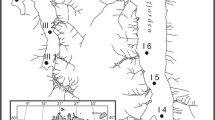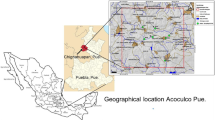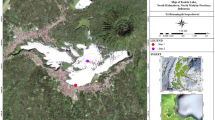Abstract
This study examines the ecological state of epilithic diatom assemblages along the lower stretch of Mandakini, a glacier-fed Himalayan river. The diatoms were sampled at four stations during winter and summer, only once in each season. Valve counts were obtained from Naphrax mounts prepared from each sample. Assemblages were recorded for each location. The software OMNIDIA Ver. 5.3 was used for computing the ecological values from the sample counts. Normally Achnanthidium spp. dominated the assemblages, except Nitzschia fonticola (Grunow) at S1 (Kund) and Encyonema minutum (Hilse in Rabh) at S4 (Rudraprayag), only during summer. The ecological values revealed that the assemblages were in β-mesosaprobic and mésotraphentic states. However, at S4, trophic state was observed to be eutraphentic. Louis Leclercq index indicated that organic pollution was nonexistent, while the anthropogenic eutrophication was low except at S2 (Tilwara) and S3 (Medanpur) in summer and was moderate at S4 in winter characterized by a lean flow. The most abundant indicator taxa for anthropogenic eutrophication are varied; Cymbella tumida (Brebisson-Van Heurck) at S1, Encyonema minutum at S2, S4 while Surirella aungusta (Kutzing) at S3. Ordination showed that the taxa indicating degradation and anthropogenic eutrophication figured as characteristic taxa at respective locations.



Similar content being viewed by others
References
Alakananda B, Mahesh M K and Ramachandra T V 2013 Role of environmental variables in diatom distribution in urban wetlands of peninsular India; Diatom 29 1–11.
Bere T and Tundisi J G 2011 Influence of land-use patterns on benthic diatom communities and water quality in the tropical Monjolinho hydrological basin, São Carlos-SP, Brazil; Water SA 37 (1) 93–102.
Cantonati M, Corradini G, Jüttner I and Cox E J 2001 Diatom assemblages in high mountain streams of the Alps and the Himalaya; Nova Hedwigia, Beih 123 37–61.
Chessman B C and Townsend S A 2010 Differing effects of catchment land use on water chemistry explain contrasting behaviour of a diatom index in tropical northern and temperate southern Australia; Ecol. Indic. 10 620–626.
Denys L 1991 A checklist of the diatoms in the Holocene deposits of the western Belgian coastal plain with a survey of their apparent ecological requirements. I. Introduction, ecological code and complete list; Profess. Paper Belg. Geolog. Dienst 246 1–41.
Descy J P and Coste M 1990 Utilisation des diatomeés benthiques pour l’evaluation de la qualitédes eaux courants; Rapport Final, EC contract B-71–23, Univ. Namur- CEMAGREFF, Bordeaux.
Dixit A S, Dixit S S and Smol J P 1992 Long-term trends in lake water pH and metal concentrations inferred from diatoms and chrysophytes in three lakes near Sudbury, Ontario; Can. J. Fish. Aquat. Sci 49 17–24.
Fore L S and Grafe C 2002 Using diatoms to assess the biological condition of large rivers in Idaho (USA); Freshwat. Biol. 47 2015–2037.
Håkansson S 1993 Numerical methods for the inference of pH variations in mesotrophic and eutrophic lakes in southern Sweden – a progress report; Diatom Res. 8 (2) 349–370.
Hill B H, Herlihy A T, Kaufmann P R, Stevenson R J and Mccormick F H 2000 The use of periphyton assemblage data as an index of biotic integrity; J. North American Benthol. Soc. 19 50–67.
Hofmann G 1994 Aufwuchs-Diatomeen in Seen and ihre Eignung als Indikatoren der Trophie; Biblio. Diatomol. 30 1–241.
Hustedt F 1931–1959 Die Kieseialgen Deutschlands Oesterrichs und der Schweiz Bd. 7, Teil 2, Translated by N G Jensen as The Pennate Diatoms 1985, Koeltz Scientific Books, Koenigstein, 918p.
Jüttner I, Rothfritz H and Ormerod S J 1996 Diatoms as indicators of river quality in the Nepalese middle hills with consideration of the effects of habitat specific sampling; Freshwat. Biol. 36 475–486.
Jüttner I, Sharma S, Dahal B, Ormerod S J, Chimonides P J and Cox E J 2003 Diatoms as indicators of stream quality in the Kathmandu Valley and Middle Hills of Nepal and India; Freshwat. Biol. 48 (11) 2065–2084.
Kelly M G and Whitton B A 1995 The trophic diatom index: A new index for monitoring eutrophication in rivers ; J. Appl. Phycol. 7 433–444.
Kociolek J P and Spaulding S A 2000 Freshwater diatom biogeography; Nova Hedw. 71 223–241.
Krammer K 2002 Diatom of Europe. Diatom of European inland waters and comparable habitats (ed.) Lange-Bertalot H, The genus Cymbella, 194 pl., A R G Gantner and Verlag K G, FAL94191 Ruggell, Distributed by Koeltz Scientific Books, Koenigstein, Vol. 3, 584p.
Krammer K 2003 Diatom of Europe. Diatom of European inland waters and comparable habitats (ed.) Lange-Bertalot H, The genus Cymbopleura, Delicata, Navicymbula, Gomphocymbellopsis and Afrocymbella, 164 pl., A R G Gantner, Verlag K G, FAL94191 Ruggell, Distributed by Koeltz Scientific Books, Koenigstein, Vol. 3, 530p.
Krammer K and Lange-Bertalot H 1999 Bacillariophyceae. Teil 2. In: Süsswasser Flora von Mitteleuropa Band 2/2 Bacillariaceae, Epithemiaceae, Surirellaceae (eds) Ettl H, Gerloff J, Heyning H and Mollenhauer D, 184 pl., Spektrum Akademischer Verlag, Heidelberg, Berlin, 611p.
Krammer K and Lange-Bertalot H 1986–1991 Bacillariophyceae. Die Süsswasserflora von Mitteleuropa. Vol. 2/1 Naviculaceae, pp. 1–876 mit 206 pl., Vol. 2/2 Bacillariaceae, Epithemiaceae, Surirellaceae, pp. 1–596 (1988), Vol 2/3 Centrales, Fragilariaceae, Eunotiaceae, pp. 1–576 (1991), Vol. 2/4 Achnanthaceae, Kritische Erganzungen zu Navicula (Lineolatae) und Gomphonema, pp. 1–437 (1991), Vol. 5, English and French translations of the keys and supplements (2000). Stuttgart and Heidelberg.
Lange-Bertalot H 1979 Pollution tolerance of diatoms as a criterion for water quality estimation; Nova Hedwigia 64 285–303.
Lange-Bertalot H 2001 Diatoms of Europe – Diatoms of European inland waters and comparable habitat (ed.) Lange-Bertalot H, Vol. 2: Navicula sensu stricto. 10 genera separated from Navicula sensu lato, Frustulia, Koeltz Scientific Books, Gantner Verlag, Konigstein, 526p.
Lamb M A and Lowe R L 1987 Effects of current velocity on the physical structuring of diatom (Bacillarilophyceae) communities; Ohio J. Sci. 87 72–78.
Lobo E A, Katoh K and Aruga Y 1995 Response of epilithic diatom assemblages to water pollution in rivers in the Tokyo Metropolitan area, Japan; Freshwat. Biol. 34 191–204.
Manel S, Buckton S T and Ormerod S J 2000 Testing large scale hypotheses using surveys: The effects of land use on the habitats, invertebrates and birds of Himalayan rivers; J. Appl. Ecol. 37 756–770.
Moresco C and Rodrigues L 2014 Periphytic diatom as bioindicators in urban and rural streams; Acta Scientiarum. Biol. Sci. Maringá 36 (1) 67–78, doi: 10.4025/actascibiolsci.v36i1.18175.
Nautiyal P and Mishra A S 2013 Epilithic diatom assemblages in a mountain stream of the lesser Himalaya (India): Longitudinal patterns; Internat. J. Ecol. Env. Sci. 39 (3) 171–185.
Nautiyal P, Nautiyal R and Verma J 2007 Ecological state of the diatom assemblages as indicators and water quality of Mandakini basin, Garhwal region (Lesser Himalayan streams); In: Proceedings National Symposium on Limnology (eds) Venkatramani B, Puranik V D, Apte S K, Gour H N, Sharma S K, Sharma L L, Durve Y S, Gupta H C L, Verma P C and Sharma B K, pp. 284–287, February 19–21 2007: Board of Research in Nuclear Sciences, Department of Atomic Energy, Mumbai.
Ormerod S D, Rundle S M, Wilkinson G P, Daly K M and Jüttner I 1994 Altitudinal trends in the diatoms, bryophytes, invertebrates and fish of a Nepalese river system; Freshwat. Biol. 32 309–322.
Palmer C M 1977 Algae and water pollution: An illus-trated manual on the identification, significance, and control of algae in water supplies and in polluted water; U.S. Environmental Protection Agency, Cincinnati, Ohio, EPA-600/9-77-036.
Patrick R and Reimer C W 1966 The diatoms of the United States exclusive of Alaska and Hawaii. Volume 1: Fragilariaceae, Eunotiaceae, Achnanthaceae, Naviculaceae, Philadelphia: Academy of Natural Sciences, 688p.
Potapova M and Charles D F 2002 Benthic diatoms in USA rivers: Distribution along spatial and environmental gradients; J. Biogeogra. 29 167–187.
Prygiel J, Whitton B A and Bukowska J (eds) 1999 Use of algae for monitoring rivers; III Agence de Leau, Artois Picardie.
Rimet F 2012 Recent views on river pollution and diatoms; Hydrobiologia 683 1–24, doi: 10.1007/s10750-011-0949-0.
Soininen J 2003 Heterogeneity of benthic diatom communities in different spatial scales and current velocities in a turbid river; Archiv fur Hydrobiologie 156 (4) 551–564, doi: 10.1127/0003-9136/2003/0156-0551.
Stevenson R J and Pan Y 1999 Assessing environmental conditions in rivers and streams with diatoms; In: The Diatoms: Applications for the Environmental and Earth Sciences (eds) Stoermer F and Smol J P (Cambridge: Cambridge University Press), pp. 11–40.
Torrisi M and Dell’Uomo A 2001 Les diatomées benthiques des parties rhithrales et potamales des cours d’eau de l’Apennin central (Italie) et leurs significations écologiques; Algological Studies 102 35–47.
Van Dam H, Merten S A and Sinkeldam J 1994 A coded checklist and ecological indicator values of freshwater diatoms from the Netherlands; Netherlands J. Aquat. Ecol. 28 117–133.
Walsh G and Wepener V 2009 The influence of land use on water quality and diatom community structures in urban and agriculturally stressed rivers; Water SA 35 (5) 579–594.
Watanabe T, Asai K, Houki A, Tanaka S and Hizuka T 1986 Saprophilous and eurysaprobic diatom taxa to organic water pollution and Diatom Assemblage Index (DAIpo); Diatom 2 23–73.
Whitton B A and Kelly M G 1995 Use of algae and other plants for monitoring rivers; Australian J. Ecol. 20 45–56.
Whitton B A, Rott E and Friedrich 1991 Use of Algae for monitoring rivers. Proceedings of an International symposium, Landesamt für Wasser und Abfall Nordrhein-Westfalen, Düsseldorf.
Acknowledgements
The author (PN) acknowledges the Uttarakhand Council for Science and Technology (UCOST), Dehradun, for financial support via Project No. UCS & T/R & D/LS-33/06-07/1108. The authors are thankful to Dr K R Singh for help in sample collection. They are also grateful to the Head, Department of Zoology, H.N.B. Garhwal University, Srinagar, for providing library facilities during the present study.
Author information
Authors and Affiliations
Corresponding author
Rights and permissions
About this article
Cite this article
Nautiyal, P., Mishra, A.S. & Verma, J. The health of benthic diatom assemblages in lower stretch of a lesser Himalayan glacier-fed river, Mandakini. J Earth Syst Sci 124, 383–394 (2015). https://doi.org/10.1007/s12040-015-0547-z
Received:
Revised:
Accepted:
Published:
Issue Date:
DOI: https://doi.org/10.1007/s12040-015-0547-z




